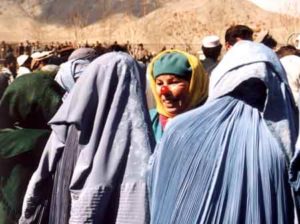As some of you may know, my Master’s Thesis was called “The Search for Indigenous Clown Forms in Afghanistan” (of course it was), stimulated in part by participation in a humanitarian mission to Afghanistan in February of 2002 with the the Italian military, an Italian film crew, and approximately two dozen clowns, mostly Italian. My passion for Silk Roads clowning continues unabated.
Thus, this blog entry! This is an excerpt (sadly made slightly ‘rumpled’ in tone in my attempt to cut words) from a paper I presented at a Silk Roads Conference in Australia. It also provides a working definition/explanation for clowning (which is really a social phenomenon, not a particular costume or make-up). I am breaking it into two parts for more readablility (Check out part two, what is clowning).
In any discussion of clowning, images of the court jesters of Europe and of Western antiquity prevail. Their presence in literature and common social construct is so profound that even in the United States (where, obviously, there have never been court jesters) they are as well known as the clowns of the Ringling Brothers, Barnum and Bailey Circus and the Cirque du Soleil. Jesters were long an integral part of Silk Road courts as well. Modern day aficionados of the form recognize the traditional importance of clowns in a court or a community; they are ‘the wise fools’, the touchstones of human nature, and those who reflect the weaknesses and strengths of a people. Clowns are not only a medium by which a community regains internal harmony and mutual caretaking, but also by which strengthens its identity and offers resistance in the face of external oppression.
There are traces of the clown forms from these regions that are pre-Islamic, detectable primarily through etymology and through current clown customs that have existed so long that they are described as heritage. Marcus Aurelius claims that the use of masks by the Greeks came from Central Asia, and indeed the word “Mask” comes from the Old Italian word “maschera” from the word “maskara” adopted into Arabic as a result of trade and invasion. “Mask” is also the word for the facial hide of an animal, particularly a goat or sheep. The tanned hide of a goat or sheep fits the human face well, as the eye sockets line up with our own and the outer contours are also approximately the same size. Such masks were worn in sacred rituals both serious and humorous throughout ancient Central Asia.
Vestiges of these customs remain in the goat horns that adorn some of the rural mountain Islamic shrines in Afghanistan, in the modern (as of the 1970s) traditions and celebrations in some regions of Pakistan, and in the legacy of masks or mask-like makeup by clowns in Bali, India, China, Japan, Russia, and Europe. (Of course, they are also the likely source of the western Christian notion of the devil as having horns and other goat features.) The Italian clown form commedia dell‘arte has a predominance of masked characters, and the oldest character, Arlecchino, has a lump on the right side of his forehead, which is said to be either a syphilis lump or a goat/devil horn. Finally, the clowns of Kashmir are called “maskara”, and their ‘make-up masks’ include red markings on the cheeks and a big red nose.
The exchange of styles, skills, characterizations and so forth was (and is) facilitated by the itinerant nature of performers. Three main reasons why performing clowns traveled were:
*The search for new markets
*As part of royal court retinue (they were expected to accompany various court members)
*Self-preservation; as laws changed and social pressure increased, it became in the clowns best interest to keep moving
